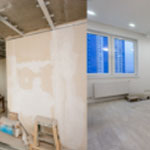
If your project involves addition or alterations to your existing dwelling, see below for useful information.
An addition is where the footprint of the building is increased. This will most likely need a building consent and possibly resource consent. Check with your Council.
To a lot of people, alterations and renovations are the same things, but
If a building consent is required, one will only be granted for the alteration of an existing building (see MBIE guidance):
Or part of an existing building, if the Territorial Authority (the Council) is satisfied that:
After the alteration, the building will comply, as nearly as is reasonably practicable, with the requirements of the building code that relates to –
(i) means of escape from fire; and
(ii) access and facilities for persons with disabilities (if it is a building type where this is required – see list);
AND the building will, –
(i) if it complied with the other requirements of the building code immediately before the building work began, continue to comply with those provisions; or
(ii) if it did not comply with the other requirements of the building code immediately before the building work began, continue to comply at least to the same extent as it did previously.
However, in some circumstances, the Council can issue a written notice to the owner that allows an alteration of an existing, or part of an existing building, without the building complying with certain requirements of the building code, that have been identified by the Council, if the Council is satisfied that:
(a) if the building were required to comply, the alteration would not take place; and
(b) the alteration will result in improvements to the building that relates to –
(i) means of escape from fire; or
(ii) access and facilities for persons with disabilities; and
(c) the improvements referred to in (b) outweigh any loss, harm or damage that is likely to occur as a result of the building not complying with the relevant provisions of the building code.
Considerations for granting a building consent
If the building is subject to an Earthquake Prone Building (EPB) Notice, then section 112 is replaced by section 133AT in relation to an application for a building consent for the alteration of a building or a part of a building. The key points are, starting at section 133AT (2):
(2) A building consent authority (Council) must not grant a building consent for the alteration of the building or part unless the building consent authority is satisfied that,—
(a) After the alteration, the building will comply, as nearly as is reasonably practicable, with the provisions of the building code that relates to—
(i) means of escape from fire; and
(ii) access and facilities for persons with disabilities (if this is a requirement in terms of section 118); and
(b) After the alteration, the building will,—
(i) if it complied with the other provisions of the building code immediately before the building work began, continue to comply with those provisions; or
(ii) if it did not comply with the other provisions of the building code immediately before the building work began, continue to comply at least to the same extent as it did then comply; and
(c) in the case of a substantial alteration, the alteration includes the necessary seismic work. An alteration of a building is a substantial alteration if the territorial authority is satisfied that the alteration meets criteria prescribed under section 401C(c).
(3) Despite subsection (2)(a) a territorial authority may, by written notice to the owner of the building or part, specify 1 or more of the provisions of the building code referred to in subsection (2)(a) and allow the alteration of the building or part without the building complying with the specified provisions if the territorial authority is satisfied that—
(a) the alteration includes the necessary seismic work; and
(b) if the building were required to comply with the specified provisions, it would be unduly onerous for the owner in the circumstances; and
(c) the permitted non-compliance with the specified provisions is no more than is reasonably necessary in the light of the objective of ensuring that the building or part is no longer earthquake-prone; and
(d) after the alteration, the building will continue to comply with the specified provisions, and other provisions of the building code, to at least the same extent as it complied with those provisions immediately before the building work began.
Defining a substantial alteration
The applicant must provide evidence as to whether or not the alteration is a substantial alteration when applying for the building consent. Refer to MBIE guidance on how to calculate this:
Other relevant legislation if the building is used by the public:
Further Information
The owner of a building with a specified intended life must not extend its life without the written consent of the territorial authority.
Please see Sec 116 of the Building Act 2004 for more information